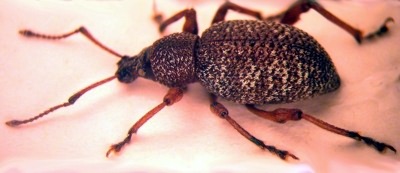Pests
Otiorhynchus turca Boheman - Turkish Vine Weevil
Systematic position.
Class Insecta, order Coleoptera, family Curculionidae, genus Otiorhynchus Germar. Closely related to O. tiflensis Rtt. (= O. karthelianus Csiki), differing from the latter in slanting contour of the elytral apical declivity.Biological group.
Pest of vine.Morphology and biology.
Body is coal-black or reddish-brown, antennae and legs occasionally reddish. Body length is 8-11 mm. Eyes moderately convex but not protruding beyond head contour. Frons are shallowly depressed. Pronotum compressed in basal half, disc of pronotum covered with strongly convex and shiny granules. Second funicular segment twice as long as first; 3rd-7th segments somewhat less than twice as long as wide. First segment of club slightly compressed in basal part, approximately as long as the rest of the segments combined. Adult is wingless. Elytra oblong-ovate, with slanting apical declivity. Large shiny granules arrange rows on elytral intervals. Femur with a small tooth, which is subequal on each pair of legs. Oval and hairlike goldish scales form small spots on elytra. Legs are covered with hairlike vestiture. Male unknown. Additional feedings is necessary for overwintered adults before oviposition. Adults devour buds first and then eat leaves. Oviposition begins the 2nd third of June. Optimal temperature for adults is about 15-23°C. Fertility is higher after feeding on vine, somewhat less on currants, sweet cherry, apricot and apple. Total fertility is about 600-2000 eggs. Egg subglobular, 0.3-0.5 mm in diameter. At first the egg is whitish, later it becomes reddish-brown. Female lays eggs on the surface layer of soil or under litter. Eggs development lasts 12-14 days. Relative humidity of 90-100% and air temperature 18-29°C are optimal for embryogenesis. Body length is 1 mm in the first instar larva and 10-12 mm in the last instar. The larva is white with brownish head. 12-20°C is the optimum temperature for larvae, molting 6 times. Larvae bury themselves at depth of 30-40 cm after increase of temperature during summer. Some of them go upward in autumn. Only adult and larvae of the last instars occur in soil from November until April. Pupation occurs in vertical soil cradles, with head directed upward. Pupa white, about 8.5-10.5 mm in length. Majority of pupae occurs at depth of 5-10 cm. The pupa develops 11-18 days. Young adults emerge during June-July; at first they are soft and light in color.Distribution.
Black Sea coast of the Bulgaria and Turkey. In the former USSR, it is distributed in the southwest of the Krasnodar Territory, between Anapa and Tuapse.Ecology.
Polyphage, preferring vine and sweet cherry; avoiding vines with dense pubescence on leaves; preferring loose soil. Adults hibernate under litter and in soil. They perish totally after frost -10°C at depth 10 cm. Overwintered adults appear from the end of March until the beginning of April and devour buds. Adults are mainly active at nighttime, but they can be found on host plants in daytime, especially in spring. The beetle activity depends on the weather. Many beetles are sometimes infected by green muscardine (Metarrhizium anisopliae Metsch.).Economic significance.
Adults, and larvae to a lesser degree, damage plants. Every beetle devours about 10 buds in spring. At peak of abundance, about 160 beetles occur per 1 shrub of vine, or 140 larvae per 1 sq. m. Control measures include treatment of ground with a cultivator in period of mass pupation. Pesticide treatment is necessary during spring after mass emergence of beetles.Reference citations:
Batiashvili, I.D. & Dekanoidze, G.I. 1968. To the knowledge of Otiorrhynchus turca Boh. . a new pest for Georgia. In: Proc. Georgian institute of plant protection (20). Tbilisi: Georgian institute of plant protection, p. 157-159 (in Russian).Korotyaev, B.A. 1984. Family Curculionidae. In: Kopaneva L.M., ed. Keys to harmful and useful insects and mites of fruit and berry cultures in the USSR. Leningrad: Kolos: 120-124 (in Russian).
Krasnyanskii, A.P. 1929. Otiorrhynchus turca Bohem. and its control. In: Merzhanian, A.S., Krasnokutskii, V.P., eds. Proc. Anapa Experimental Station, (5). Rostov-on-Don: North Caucasus Wine Department. P. 55-104 (in Russian).
Lipetskaya, A.D. & Ruzaev, K.S. 1958. Pests and diseases of vineyard. Moscow: Izd. sel'skokhozyaistvennoi literatury, 279 p. (in Russian).
Ruzaev, K.S. 1958. Bioecological data about Otiorrhynchus turca Bohem. Zool. Zhurn. 37(6): 855-865 (in Russian).
Silantyev, A.A. 1909. Otiorrhynchus turca Bohem. in Novorossiisk region and its control. In: Proc. of the 3rd conference of winegrowers, winemaker, fruit growers and farmers from Black Sea region in Novorossiisk. St. Petersburg: Merkushev.s printing-house. 95 p. (in Russian).


